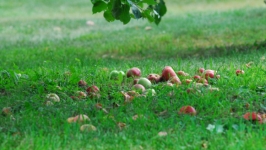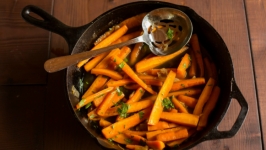Brussels Sprouts: Love Them or Leave Them!
The first written mention of Brussels sprouts dates back to 1587. Their popularity in the area around Brussels, Belgium, led to them being dubbed Brussels sprouts. Although they look like baby cabbages and are part of the same family, they are not cabbages. This vegetable is part of the cruciferous family, species Brassica oleracea.
Brussels sprouts are buds that grow along the length of a thick fibrous stalk starting at the base of the stem and working upward. Because of the labor involved with removing the buds, Brussels sprouts are often less expensive if you buy them when still on the stalk. Another incentive for doing so is the fact that this vegetable will stay fresher a great deal longer if left on the stalk. When shopping, try to find smaller sized sprouts. They are sweeter and more tender than the larger variety. Make sure that the leaves are tight and firm since loose leaves indicate older sprouts. Avoid those that are dull green, or yellow and mushy. They should be stored in a bag in the refrigerator. The fresher your Brussels sprouts are, the better they will taste. This vegetable is in season from fall through late winter, which is why they are often served at Thanksgiving and Christmas.
Today, there are dozens of varieties that come in all sizes, from those that are marble shaped to others that are golf ball like. Some popular breeds are Bubbles, Prince Marvel and Oliver. The majority of Brussels sprouts are grown in California, but this vegetable can be grown almost anywhere, even in the colder areas of our country.
Brussels sprouts are high in protein when compared to other green vegetables. They are an excellent source of vitamin K, which improves bone health. A 1/2 cup serving of the vegetable meets a day’s requirement for vitamin K. It is important to note, for those folks who are on anti-coagulant medication, that vitamin K promotes blood clotting. Therefore, Brussels sprouts may not be the wisest or safest dietary choice! The vegetable’s vitamin C content is a close second and has been shown to help eye health and protect the development of cataracts. Brussels sprouts are also a good source of folic acid, magnesium, phosphorus, vitamin B6, dietary fiber, calcium, copper, vitamin B1, potassium, iron and omega-3 fatty acids. They are also low in saturated fat and cholesterol. The U.S. Department of Agriculture’s nutrient database indicates that an uncooked cup of Brussels sprouts contains 38 calories and 56 calories when cooked.
There are a number of ways to prepare Brussels sprouts: Pan fry for a crunchier texture, roast and drizzle with olive oil and your favorite spices or try them stir-fried, steamed, boiled or grilled. Some cooks like to peel away the leaves and bake to make Brussels sprout chips. The best flavor is achieved when this vegetable is placed in a small amount of water and steamed. Drain and serve immediately with a little salt. When overcooked, the flavor and nutrients are destroyed. This vegetable can develop a strong unpleasant odor if overcooked, especially when boiled. The smell is connected to an organic compound within the vegetable that contains sulfur.
As with any unfamiliar food, folks sometimes need to cultivate a taste before they become fans. When cooked properly, Brussels sprouts can make a delicious addition to your menu. Try them with honey mustard or cheese sauce. Sprinkle with grated Parmesan cheese, balsamic vinegar or olive oil. Slice thin and serve raw in salads. Create your own culinary masterpiece! A number of years back a well-known food company did a survey that showed that Brussels sprouts were the most disliked vegetable in America. Only time will tell if this still holds true... you be the judge!








